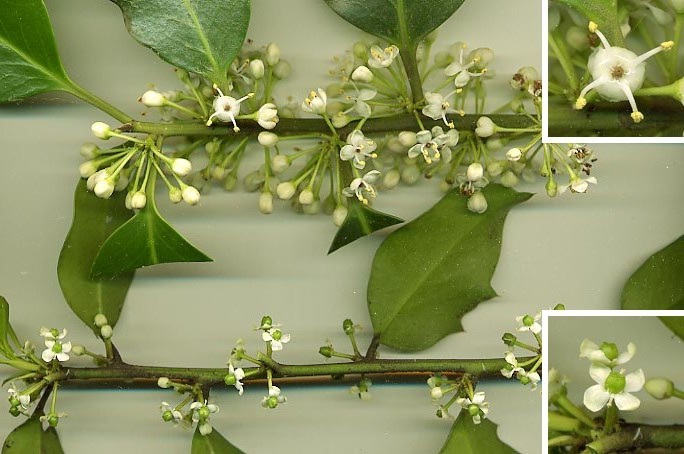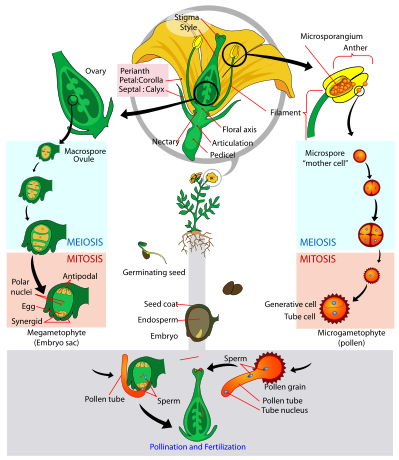The Birds and the Bees...
Before exploring this section, familiarize yourself with
the various
parts of a flower and their functions...
Ilex aquifolium is a dioecious species, so both male and
female flowers are required for reproduction. Both sexes
produce creamy, white flowers in the beginning of spring and
depend on
honey bees for fertilization. Up to 8 female trees can
be pollinated by a single male, but for optimum production a
1:3 ratio is suggested. A Holly flower has many distinct
characteristics. The sepals are egg-shaped, tend to be 4 or
5 lobed and have a membranous coating. There are typically 4
stigmas all of which lack stalks and lie directly above the
ovary and ovule. The oblong anthers are attached to the
corolla by stalks and together they make up the pollen
producing stamens. Female flowers also have stamens, but
they are most often sterile. In rare cases the fertile
stamens of female flowers will self-fertilize the ovary. The
ovary of the flower is typically 4-6 celled, while the berry
contains a 4-5 celled stone or 4 stones. Several animals
other than bees also take part in the reproduction of Holly.
Many animals contribute to the widespread habitat of Holly
by ingesting ripe berries and discarding fertilized seeds in
their feces. Thrushes, raccoons, and
rabbits are just some of the
many animal species that enjoy a flavorful Holly berry snack.

Figure 1: English Holly is a dioecious species. The top branch
above and the flower in the top, right corner are taken from a male tree. The
bottom branch above and the flower in the bottom, right corner are taken from a
female tree.

Figure 2: Angiosperm Life Cycle.
English Holly experiences a similar life cycle to thousands of other dioecious
flowering plants. It all begins with two plants, one male and one female. The
ovary of the female plant is located inside the flower. Ovules are located
inside the ovary and undergo meiosis of the macrospore followed by mitosis to
create a megagametophyte or embryo sac. In the male plant there are numerous
microsporangium that undergo
meiosis and then
mitosis creating a microgametophyte, more commonly known as pollen.
Pollination occurs when bees or
any number of small animals transfer the pollen from the male plant to the
female plant. The pollen travels down the pollen tube and finally reaches the
embryo. Fertilization takes place, followed by germination and before you know
it the cycle begins all over again.
Further
explore flowering plant reproduction by viewing this short
video...
My friends, my enemies, my dangers,
my uses...
|